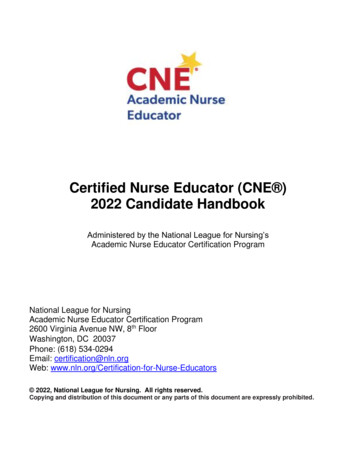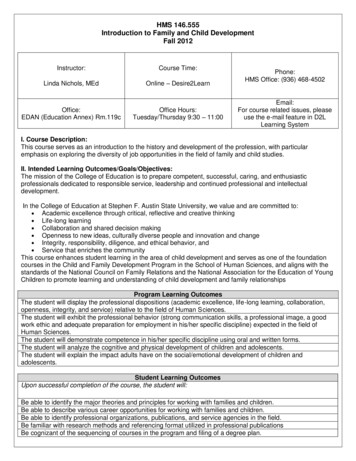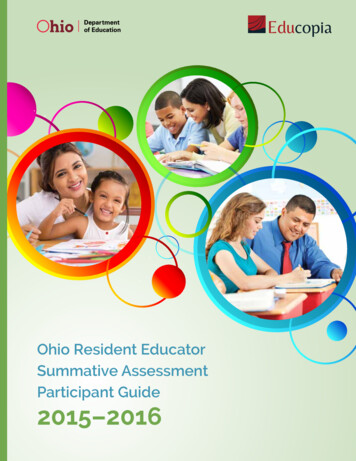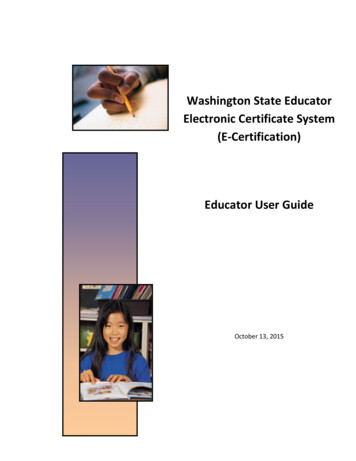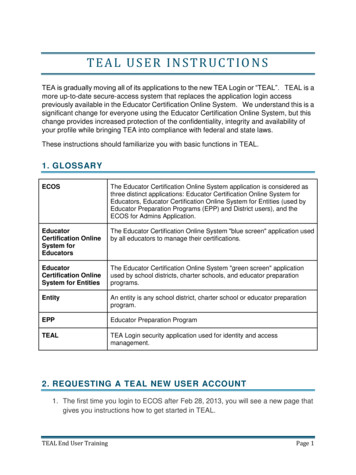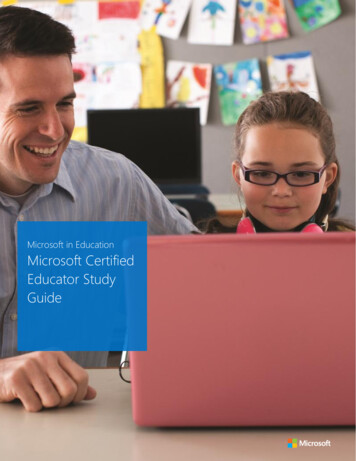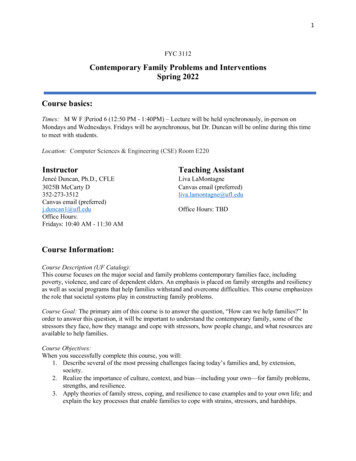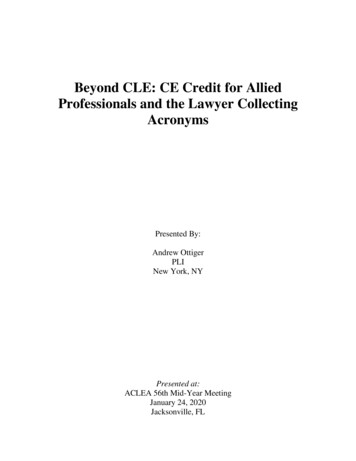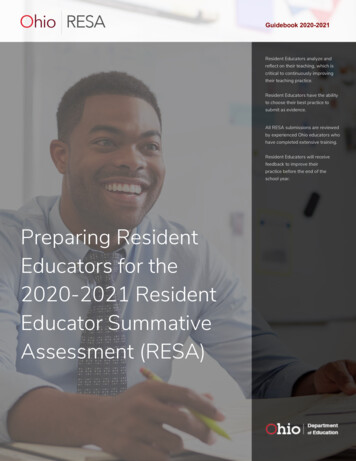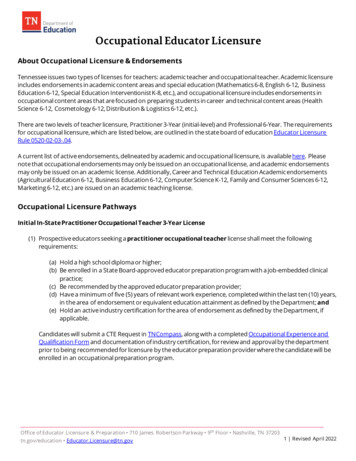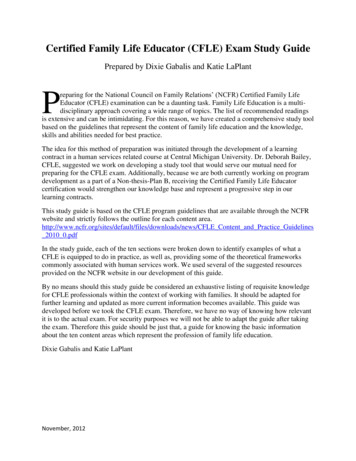
Transcription
Certified Family Life Educator (CFLE) Exam Study GuidePrepared by Dixie Gabalis and Katie LaPlantreparing for the National Council on Family Relations’ (NCFR) Certified Family LifeEducator (CFLE) examination can be a daunting task. Family Life Education is a multidisciplinary approach covering a wide range of topics. The list of recommended readingsis extensive and can be intimidating. For this reason, we have created a comprehensive study toolbased on the guidelines that represent the content of family life education and the knowledge,skills and abilities needed for best practice.PThe idea for this method of preparation was initiated through the development of a learningcontract in a human services related course at Central Michigan University. Dr. Deborah Bailey,CFLE, suggested we work on developing a study tool that would serve our mutual need forpreparing for the CFLE exam. Additionally, because we are both currently working on programdevelopment as a part of a Non-thesis-Plan B, receiving the Certified Family Life Educatorcertification would strengthen our knowledge base and represent a progressive step in ourlearning contracts.This study guide is based on the CFLE program guidelines that are available through the NCFRwebsite and strictly follows the outline for each content oads/news/CFLE Content and Practice Guidelines2010 0.pdfIn the study guide, each of the ten sections were broken down to identify examples of what aCFLE is equipped to do in practice, as well as, providing some of the theoretical frameworkscommonly associated with human services work. We used several of the suggested resourcesprovided on the NCFR website in our development of this guide.By no means should this study guide be considered an exhaustive listing of requisite knowledgefor CFLE professionals within the context of working with families. It should be adapted forfurther learning and updated as more current information becomes available. This guide wasdeveloped before we took the CFLE exam. Therefore, we have no way of knowing how relevantit is to the actual exam. For security purposes we will not be able to adapt the guide after takingthe exam. Therefore this guide should be just that, a guide for knowing the basic informationabout the ten content areas which represent the profession of family life education.Dixie Gabalis and Katie LaPlantNovember, 2012
There are two parts to each of the following 10 content areas. The first is “Content” which givesan overview of the subject matter in this area from the NCFR University and College CurriculumGuidelines. The second component includes “Practice” which relates to the tasks expected of anentry-level CFLE.I FAMILIES & INDIVIDUALS IN SOCIETAL CONTEXTS13% of ExamContent: Families in Society - An understanding of families and their relationships to otherinstitutions, such as the educational, governmental, religious, and occupational institutions insociety.e.g., Research and theories related to: Structures and Functions; Cultural Variations (familyheritage, social class, geography, ethnicity, race & religion); Dating, Courtship, Marital Choice;Kinship; Cross-Cultural & Minority (understanding of lifestyles of minority families & thelifestyles of families in various societies around the world); Changing Gender Roles (roleexpectations & behaviors of courtship partners, marital partners, parents & children, siblings, &extended kin); Demographic Trends; Historical Issues; Work/leisure & Family Relationships;Societal Relations (reciprocal influence of the major social institutions & families, i.e.,governmental, religious, educational, & economic).Practice—A CFLE is prepared to:A). Identify the characteristics, diversity, & impact of local, national, & global social systems Characteristics, diversity, and impacto Local – Small circles, individually focused, lacking diversity with the largestimpacto National – Larger affiliations, group focused, larger pool of diversity, possibilityto effect change within one’s own culture.o Global – Globally identified affiliations (e.g., Christians), can transcend acrosscultural differences, world view that has the capability to effect social change.B). Identify factors (e.g., media, marketing, technology, economics, social movements, naturaldisasters, war) influencing individuals & families from both contemporary & historicalperspectives. Contemporary factorso Technology – Has automated many tasks previously performed by individuals.o Transportation – Allows for family mobility; possibility for nomadic existence.Counterproductive to extended family relationships.o Social networking – Facebook revolutionized the way we communicate on asocial level.November, 2012
o Natural disasters – Hurricane Katrina displaced hundreds of thousands offamilies.o Economics – Recession era producing undue hardship for families Historical factorso Technology – Provided improved capabilities for industry allowing theopportunity for more family connection (families did not necessarily seize theopportunities).o Transportation – Travel not a prominent feature of families, (until the autoindustry boom) translating to more time spent w/ immediate family.o Social movements – Gave oppressed populations more rights (e.g., suffrage, civilrights movement).o Economics – The Great Depression impoverished families from the middleclasson down the socioeconomic chain.C). Identify factors that influence the relationship between work & family life Dual income families marked an improved economy but equated to less family time orinvolvement.o Less time spent on meal preparation and family dinners.o More income for material goods and services, less family contribution. Within the face of a poor economy families work longer hours for less pay. Increased need for alternative child care also increases the family's financial burden. Increased demands on interpersonal relationships.D). Identify social & cultural influences affecting dating, courtship, partner/marital choice &relationships, family composition, & family life Social/Cultural influenceso Social networking, ease of transportation options, increased access to goods/servicesand reduced parental control rigidity has changed the way in which young peopledate.o Mate selection, generally, is determined at later developmental stages than inprevious generations. Young adults are waiting longer to get married to accommodate educationalattainment and financial security. Cohabitation also contributes to increased marital age and lack of urgency fortraditional marriage rituals. Sex education, birth control options and cultural acceptance of children tounwed parental units may extend courtship periods.o Non traditional family composition is normative in current culture. Eldercare and adult children's return to the parental home (sometimes w/offspring of their own) may place four generations together under one roof.November, 2012
o Gender role expectations are vastly diverse compared to other historical periods. Women in the workforce. Women as primary wage earns of the household. Men as primary caregivers to offspring. Greater distributions of household maintenance across family unit members.E). Recognize the reciprocal interaction between individuals, families, & various social systems(e.g., health, legal, educational, religious/spiritual) Healthcareo Needs to be accessible, affordable, and confidential in order to build trust.o Families & individuals need to be honest and compliant w/ healthcare providers.o Boundary awareness. Educationo Needs to be strengths based, accessible, collaborative, diverse and inclusive whilemaintaining cultural awareness.o Families should support student learning, provide safe environments for learning,and collaborate w/ academic institutions.o Boundary awareness. Religiono Appreciation of individual family norms, traditions, values, and differences whileproviding spiritual guidance intended to strengthen family processes.o Mutual respect of doctrines governing religious organizations/affiliations.o Employing ethically sound practices for work with families.o Boundary awareness. Legalo Make families/individuals aware of legal rights and responsibilities.o Identify community based collaboratives designed to alleviate family stress.F). Assess the impact of demographics (e.g., class, race, ethnicity, generation, gender) oncontemporary families Class – Misperceptions that are conflict producing continue to pervade class distinctions. Race/Ethnicity – While tolerance has increased, families still view differences from adeficit model. Generation – Large aging population causing financial strain on social systems.Longevity associated w/ extended care may pose financial hardships for families. Sex iseducation becoming necessary for aging populations. Gender – Women becoming more instrumental in family financial stability may causeinterpersonal conflict. Men becoming more responsible in caretaking duties affectrelationship qualities.November, 2012
II INTERNAL DYNAMICS OF FAMILIES12% of ExamContent: An understanding of family strengths and weaknesses and how family members relateto each other.e.g., Research & theories related to: Internal Social Processes (including cooperation & conflict);Communication (patterns & problems in husband-wife relationships &in parent-childrelationships, including stress & conflict management); Conflict Management; Decision-makingand Goal-setting; Normal Family Stresses (transition periods in the family life cycle, threegeneration households, caring for the elderly, & dual careers); Family Stress & Crises (divorce,remarriage, death, economic uncertainty & hardship, violence, substance abuse); Special Needsin Families (including adoptive, foster, migrant, low income, military, & blended families as wellas those with disabled members).Practice—A CFLE is prepared to:A). Recognize & define healthy & unhealthy characteristics pertaining to:1). Family relationshipso Healthy characteristics Interpersonal communication - Makes unit members feel valued Mutual trust and responsibility - Makes unit members feel secure Safe environments - Promotes physical and mental health Financial stability - Increases available resources Security (warmth and responsiveness dimensions) - Promotes unitconnectedness Active response - Promotes a teamwork perspective, considers unit membercontributions essential to conflict resolution, problem solving, and decisionmakingo Unhealthy characteristics Hostility/Abuse - Increases fear, instability; decreases physical and mentalhealth Non-secure environments - Increases fear; decreases physical and mentalhealth Substance use - Decreases availability and attention Non-communication across members - Individualistic perspective Poverty - Increases family stress Low educational attainment - Lessens parental skill and knowledgeNovember, 2012
Reactive response - Lacks collaborative perspective; authoritarian leadershipstyle2). Family developmento Healthy characteristics Common goal oriented Collaborative communication Common values, norms, and traditions Adaptability in transitional periods On-time ontogenetic maturation Connectedness to unit members, as well as, the unit as a wholeo Unhealthy characteristics Individualistic goals Non-communication Differentiated values, norms, and traditions. Off-time development Maladaptation in transitional periods Emotional disconnectednessB). Analyze family functioning using various theoretical perspectives Systems perspective - Family system affects the environment and in turn is affected bythe environment. Ecological perspective - All systems are related and affect each other. Structuralist perspective - Preservation of the family structure is the most important goal. Conflict perspective - Deviation from family goals produces friction, therefore conflict;concerned w/ a return to homeostasis. Family life course perspective - Every aspect of the journey through life is important;from birth to death.C). Assess family dynamics from a systems perspective Evaluate interpersonal relationships w/in the microsystemObserve family processes and functions w/in the microsystemIdentify micro and meso system relationships and interactionsIdentify meso, macro, and exo system influences on the microsystemIdentify microsystem influences on external systemsD). Evaluate family dynamics in response to normative & non-normative stressors Normative stressors:o Time constraintsNovember, 2012
o Money managemento Transitional phases – e.g., child birth, school entry, college departure, empty nesto Lack of family resources Non-normative stressors:o Childhood death or serious illnesso Divorce, death or abandonment of a spouse/partnero Job loseo Natural disasterE). Evaluate family dynamics in response to crises Family dynamics that either increase or decrease family stresso Decrease – Open and collaborative communication, maintaining routines,identifying available resourceso Increase – Hostility, blame laying, no communication, substance abuse, giving upF). Facilitate & strengthen communication processes, conflict-management, & problem-solvingskills Barriers:o Perceptions & prejudiceso Anxiety & defensivenesso Conflicting agendaso Language and/or culture Effective listening:o Be fully presento Interpret descriptively, not judgmentallyo Observe nonverbal cueso Reflect disclosed contento Accent & encourageG). Develop, recognize, & reinforce strategies that help families function effectively Develop:o Establish routines and backup planso Model and encourage effective listeningo Structure family-time e.g., family game nighto When possible, establish decision-making collaboration Recognize:o Identify and verbalize interactions that are healthyNovember, 2012
o Identify the uniqueness of individual family members , as well as, unique qualitiesof the family unito Acknowledge behaviors that are deviation dampening or amplifying for goalattainment Reinforce:o Acknowledge successeso Encourage positive progressiono Model healthy behavioro Promote educationIII HUMAN GROWTH & DEVELOPMENT ACROSS THE LIFE SPAN12% of ExamContent: An understanding of the developmental changes (both typical and atypical) ofindividuals in families across the lifespan. Based on knowledge of physical, emotional,cognitive, social, moral, and personality aspects.e.g., Research and theories related to: Prenatal; Infancy; Early and Middle Childhood;Adolescence; Adulthood; Aging.Practice—A CFLE is prepared to:A). Identify developmental stages, transitions, tasks, & challenges throughout the lifespan Early childhood - Ontogenetic maturation – socialization – gross & fine motor skills potty training Early adolescences - Identity formation – puberty – decision making – peer acceptance Early adulthood – Exploration and commitment – launching - critical thinking responsibility Middle adulthood – Professional development – reproductive decisions – group think,empathy – time, relationship, and family management Late adulthood – Twilight – retirement – decline in cognitive function – companion loss,care competence, decline in physical healthB). Recognize reciprocal influences Individual development on familieso Parental return to school /employment will change individual roleexpectations initially lending to unbalanced equilibrium.o Offspring deficits (e.g., autism, chronic illness) may breed resentmentamongst family member relationships.o Declining capacities of aging family members may change the structure of thehome environment for care purposes.November, 2012
o Active parental involvement strengthens family stability Family development on individualso Established norms (e.g., designated chores), values (e.g., importance ofeducation), and traditions (e.g., a family camping trip each year) w/in thefamily unito Families in crisis may establish a developmental trajectory for adverseoutcomes.o Continuity/discontinuity in behaviors lead to stability/instabilityC). Recognize the impact of individual health & wellness on families Families that care about their health care about other social issuesHealthy families engage in fewer risky behaviorsIndividual health models positive behaviorGood mental health promotes family equilibriumPositive health/wellness may increase family financial stabilityD). Assist individuals & families in effective developmental transitions Validate transitional challengesVocalize concerns – client perspectiveIdentify reciprocal affects – positive and negativeIdentify effective management strategiesProvide resource and educational opportunitiesE). Apply appropriate practices based on theories of human growth & development toindividuals & families Early childhood – Education, socialization groups, gross and fine motor development,adequate nutrition and physical activity Adolescence – Education, socialization groups, community connectedness, effectivecommunication, autonomy development, adequate nutrition and physical activity Early adulthood – Education, community connectedness and involvement, personalresponsibility, effective communication, skill development, interpersonalrelationships/connectedness Middle adulthood – Identify personal, professional, and community resources, identifyfamily/individual strengths, socialization groups, personal/family responsibility, skilldevelopment, interpersonal relationships/connectedness Late adulthood – Care, health, and financial management, interpersonalrelationships/connectedness, grief/loss managementNovember, 2012
IV. HUMAN SEXUALITY8% of ExamContent: An understanding of the physiological, psychological, and social aspects of sexualdevelopment across the lifespan, so as to achieve healthy sexual adjustment.e.g., Research and theories related to: Reproductive Physiology; Biological Determinants;Emotional and Psychological Aspects of Sexual Involvement; Sexual Behaviors; Sexual Values& Decision-Making; Family Planning; Physiological & Psychological Aspects of SexualResponse; Influence of Sexual Involvement on Interpersonal Relationships.Practice—A CFLE is prepared to:A. Recognize the biological aspects of human sexuality Sex is biological, gender is a social construct XX female XY male May be biologically male or female but choose to live as opposite External female genitals include mons pubis, clitoris, labia majora, labia minora;collectively known as vulvao Mons pubis covers pubic bone; in puberty starts to cover with pubic hairo Clitoris contains high concentration of nerve endings, extremely sensitive tostimulation; sole function is sexual arousal, enlarges when aroused, spasmsassociated with orgasmo Labia majora are two folds of spongy flesh extending from the mons pubiso Labia minora are smaller folds within the labia majora, sensitive and swell duringarousal Internal female genitals include vagina, uterus, cervix, ovaries, and fallopian tubeso Vagina is a flexible muscle that serves two functions 1. Encompasses the penisduring sexual intercourse to aid in sperm entering into the uterus 2. It is the birthcanalo During arousal expands and lubricates to encompass the penis and make spermable to survive Hymen is a thin membrane containing blood vessels,o Uterus is a hollow thick-walled muscular organ in the pelvic cavityo Cervixo Ovaries one on each side of the uterus; ovaries are gonads, an organ that producesgametes (sex cells) for reproduction Ova is the egg that ovaries produceo Fallopian tubes transport ova (egg) Female hormones- estrogen and progesterone Ovulation Cycleo Occurs in one ovary each month; approximately 28 day cycleo Follicular Phaseo Ovulatory Phaseo Luteal Phase Menstrual Cycleo Menstrual Phase-shedding of endometriumo Proliferative Phase-endometrium thickensNovember, 2012
o Secretory Phase-produces nutrients to sustain embryo Male external genitals are the penis and scrotumo Penis is the organ through which sperm and urine passes; three sections root(attaches the penis within the pelvic cavity), shaft (hangs free), head (enlarged,passes urine)o Scrotum pouch of skin that holds two testicles Male internal genitalso Testes are reproductive glands for sperm production and hormone productiono Epididymis and Vas Deferens ducts that carry sperm from testicles to the urethrafor ejaculationo Seminal vesicles and prostate secrete fluid which makes up seminal fluido Cowper’s glands secrete thick mucus prior to ejaculation Male hormone- testosterone Spermatogenesis (production of sperm)o Formed in seminiferous tubules (takes 64-72 days)o Immature sperm stored in epididymis; takes about 20 days to travel through theepididymis, which makes them become fertile and mobile Semen productiono Made up of secretions in seminal vesicle and prostate gland1. Sexual functioning Female responseo Excitement (swelling of clitoris, vagina lubricates), plateau (same changes asexcitement, clitoris highly sensitive), orgasm (muscle contractions), resolution(unaroused) Male responseo Excitement (penis becomes erect), plateau (muscles at base of penis haverhythmic contractions, testes retract), orgasm (ejaculation), resolution (unaroused;refraction period) Intimacy and closeness Reproduction2. Reproductive health Sperm travels through the fallopian tubes, if there is an egg in the ovary the spermfertilizes the egg, the fertilized egg moves into the uterus and grows into a baby3. Family planning Use of birth control (condoms, pill, IUD, diaphragm, rhythm method, etc.) Use of birth control is more socially accepted today (some restrictions) Some religions do not condone the use of birth control In the US women are waiting longer to have children and having less children Cultural differences in access to birth control and/or wanting large families4. Sexually transmitted infections (STIs) Passed from person to person through sexual contact; both curable and non-curable Growing threat to public health; known as “silent” because undiagnosed/underdiagnosed Are the most common reported infectious disease in the US More serious for women in incidence and for impact on health Those 15-24 at greater risk due to risk taking and multiple partnersNovember, 2012
Higher rates in African Americans, Native Americans, and LatinosSpread through: multiple sex partners, high-risk sex partners (someone who has hadmultiple partners), high-risk sexual behavior (anal intercourse, prostitute), inconsistent orno condom use, substance abuse, poverty, lack of access to health careB. Recognize the psycho-social aspects of human sexuality Casual sex, sex outside of marriage, multiple sex partners is more common in society Gay and lesbian sexual relationships are more common, but may not be fully accepted bysociety Judgment from others or partner may impact sexual functioning and actions1. Characteristics of healthy & ethical sexual relationships Both partners consent to sex, both of age Boundaries, being able to communicate with partner No partner has power over another (like domestic violence situations) Being able to communicate about feelings and attitudes especially about birth control2. Interpersonal dynamics of sexual intimacy Sexual intimacy may be a source of conflict in couples (lack of sex, not satisfying) Couples who have had one partner have sex outside of marriage (affair) had . May bring great satisfaction into marriage Increase communication3. Risk factors (e.g., substance abuse, social pressures, media) Media influences what people view as the norm for sex and relationships Peers influence decision making (have most impact) Parents also have large impact on sexual decision making Using drugs or alcohol can limit inhibitions to sexual intercourse; may lead to riskydecision making when it comes to sex Purity pledges often from a religious context are often ineffective and can lead tounprotected sex due to lack of knowledge of contraceptionC. Address human sexuality from a value-respectful position Sexual partners are diverse, recognize and respect sexual choices Lesbians, gay men, transgender Know the practices and risks for these groups Recognize own bias Take into account cultural norms including religious valuesV. INTERPERSONAL RELATIONSHIPS9% of ExamContent: An understanding of the development and maintenance of interpersonal relationships.e.g., Research and theories related to: Self and Others; Communication Skills (listening,empathy, self-disclosure, decision making, problem-solving, and conflict resolution); Intimacy,Love, Romance; Relating to Others with Respect, Sincerity, & Responsibility.Practice—A CFLE is prepared to:A. Recognize the impact of personality & communication styles Three types of communication styles- passive, aggressive, assertiveNovember, 2012
Communication styles can hurt or help a relationshipCouples who are assertive will also become more self-confident and lead into a positivecycle of communication Couples who are passive (avoidant) one partner will become dominant and have anegative cycle of communication Self-disclosure-more self-disclosure will allow couples to become closer (not all partnersare comfortable with high levels of disclosure) Listening-men and women listen and communicate differentlyB. Recognize the developmental stages of relationships Single young adults leave home The joining of families through marriage Families with young children Families with adolescents Launching children Families in later lifeC. Analyze interpersonal relationships using various theoretical perspectives Symbolic interaction-people communicate through symbols and interpret the words andactions of otherso “Looking glass self” is how you see yourself by the way others treat you and whatthey say to youo Self-fulfilling prophecy is that someone defines a situation people act in a waythat is expected Social exchange-maximizes benefits and minimizes costso Costs are negative such as negative exchanges, complaints, critical remarks;rewards are compliments, agreements, compromiseso When benefits outweigh the costs partners profit (positive relationship)D. Develop & implement relationship enhancement & enrichment strategies Develop interpersonal skills Recognize/state the positive qualities of spouse Spouses privately write down reflections on a topic or question then discuss topic orquestion in depth with each other ACME program focuses on security and community building, development of individualand couple awareness, development of knowledge and skill, planning for intentionalgrowth, celebration and closureE. Develop & implement effective communication, problem solving, & conflict managementstrategies Teaching couples to be assertive with each other can strengthen communication Teach couples the value of fair fighting and having fighting rules Practice “I messages” and active listening Work through a recent argument/problem Effective communicationo Make communication a priorityo Establish and maintain eye contacto Ask open ended questionso Use reflective listeningNovember, 2012
o Use “I” statementso Toucho Use “soft” emotions (sad, hurt)o Avoid negative expressivityo Say positive things about your partnero Tell your partner what you wanto Stay focused on the issueo Make specific resolutions to disagreementso Give congruent messageso Share powero Keep the process of communication goingF. Communicate aspects of relationships within the context of their developmental stages Single young adults leave homeo Young adult needs autonomy to separate from family and gain independence toestablish goals in career, peer relations, and school The joining of families through marriageo Couples must reorganize relationships with extended family and friends toaccommodate new spouseo Need to establish marriage new traditions or integrate traditions from family oforigin Families with young childreno Adjustments in the marital system need to be made; change in roleso Establishing or extending relationships to include grandparents Families with adolescentso More flexibility for children to gain independence Launching childreno Empty nest-couples must rely on each other after children leave homeo Boomerang children (children come back after being away, after graduation ordivorce)o Move towards an adult-adult relationship with childreno Prepare to have relationships with in-laws and grandchildren Families in later lifeo Maintain support with family members/spouseo Dealing with loss of spouse, sibling, child, peerVI FAMILY RESOURCE MANAGEMENT10% of ExamContent: An understanding of the decisions individuals and families make about developing andallocating resources including time, money, material assets, energy, friends, neighbors, andspace, to meet their goals.e.g., Research and theories related to: Goal Setting and Decision-Making; Development andAllocation of Resources; Social Environment Influences; Life Cycle and Family StructureInfluences; Consumer Issues and Decisions.November, 2012
Practice—A CFLE is prepared to:A). Identify personal, familial, professional, & community resources available to families Personalo Work ethic, parenting style, communication style, temperament, values Familialo Family processes, interactions, communication, decision making, traditions,norms, values Professionalo Assistance programs (food, housing, financial), mental health services (healthdepartments, support groups), education (skills training, parenting classes) Communityo Religious affiliations, outreach programs (YMCA, AA, Al-Anon,), communityaction agencies, recreational organizations, socialization groups (Mom-to Mom,Big Brothers/Big Sisters)B). Recognize the reciprocal relationship between individual/family/community choices &resources Exampleso Parenting classes will build parenting skills leading to more effective parentingpractices
Certified Family Life Educator (CFLE) Exam Study Guide Prepared by Dixie Gabalis and Katie LaPlant reparing for the National Council on Family Relations' (NCFR) Certified Family Life Educator (CFLE) examination can be a daunting task. Family Life Education is a multi-disciplinary approach covering a wide range of topics.
